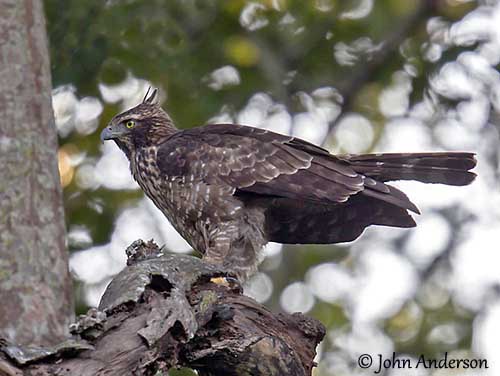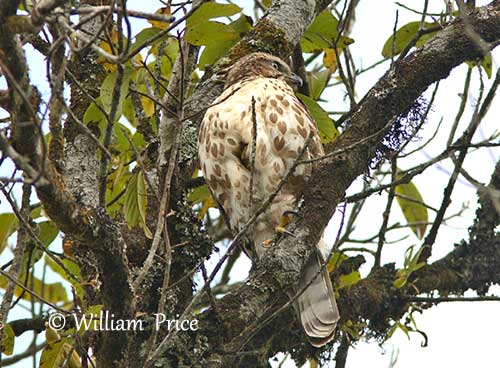
Fr: Aigle montagnard
Ang: Mountain Hawk-Eagle
All: Bergadler
Esp: Aguila-azor Montañesa
Ita: Aquilastore montano
Nd: Aziatische Kuifarend
Sd: Berghökörn
Jap: Kumataka
Photographer:
John Anderson
John Anderson Photo Galleries
William Price
PBase-tereksandpiper & Flickr William Price
Text by Nicole Bouglouan
Sources :
HANDBOOK OF THE BIRDS OF THE WORLD Vol 2 by Josep del Hoyo-Andrew Elliot-Jordi Sargatal - Lynx Edicions - ISBN: 8487334156
A Field Guide to the Birds of South-East Asia by Craig Robson. New Holland Publishers. ISBN: 9781780090498
A photographic guide to Birds of Vietnam, Cambodia and Laos by Peter Davidson. New Holland Publishers. ISBN: 9781847731418
BirdLife International (BirdLife International)
Global Raptor Information Network - Working to Conserve Birds of Prey in nature
Wikipedia, the free encyclopaedia
Welcome to WhoZoo (Jill Foley)
Mountain Hawk-Eagle Kuma-Taka (Jpn) Nisaetus nipalensis
By Toru YAMAZAKI Author © Japan Bird Research Association
Preliminary Study on the Vocal Behavior of Mountain Hawk-eagle Nisaetus nipalensis in Taiwan
Mountain Hawk-Eagle
Nisaetus nipalensis
Accipitriformes Order – Accipitridae Family
INTRODUCTION:
The Mountain Hawk-Eagle was formerly treated under the genus Spizaetus, but it is now included in the genus Nisaetus with other Old World species.
The name of this raptor indicates its favoured habitat type, the montane forests. It is visible from sea-level up to 3500 metres of elevation depending on the range.
The Mountain Hawk-Eagle is threatened by habitat loss, but it is still common throughout its range where it is resident, although some local movements are observed.
DESCRIPTION OF THE BIRD:
Biometrics:
Length: 67-86 cm
Wingspan: 130-165 cm
Weight: M: 1800-2500 g – F: 3500 g
The adult of the nominate race has dark brown upperparts with whitish bars on rump. The tail shows broad, equal-width, dark and pale bands.
The underparts are pale with heavily streaked brown breast, belly and underwing-coverts, and barred dark undersides of flight-feathers and rectrices. There are black and brown vertical streaks from throat to breast.
The head is mostly blackish with black, white-tipped, long erectile crest. However, the head may vary in colour with the age, and progressively, the coloration of the underparts from breast to belly becomes tinged with dark brown.
The bill is black with blackish cere. The eyes are orange. The legs (thighs and tarsi) are feathered and heavily barred whitish and brown. The feet are yellow with black talons.

BEHAVIOUR IN THE WILD:
The Mountain Hawk-Eagle feeds on small to medium-sized preys including mammals (hare, marten, flying squirrel, squirrel and shrew moles), birds (pheasants, jays and others) and reptiles such as snakes and lizards.
But the diet varies according to the region, and the eagle takes the most abundant preys available in the habitat.
The Mountain Hawk-Eagle hunts mainly in forests and forest edges. It hunts from perch, waiting for prey, or searching while moving from perch to perch. It may also fly above the canopy while looking for animals.
They are monogamous and the pair has long-term pair-bonds. They often stay in their home range all year round. However, outside the breeding season, they live separately.
The courtship displays usually start in autumn with aerial displays. The birds perform undulating and parallel flights together, and other acrobatic figures including approaching stoops. The nest-building starts while the courtship displays are underway. They nest in large trees on mountainsides. The area is defended and both mates chase out intruders.
The Mountain Hawk-Eagle is sedentary in its range, although some dispersion, probably by juveniles, is reported.
It soars with the wings held slightly forwards and above the body in shallow V, but it glides with the wings at body-level. The flight is agile and powerful during the displays.
REPRODUCTION OF THIS SPECIES:
The breeding season varies according to the range, and occurs between December and March in Sri Lanka, from January to April in Japan, and between February and June in the Himalayas.
Both mates build a large nest with thick dead branches for the base, and thinner sticks for the upper structure. The cup is lined with twigs and green leaves. It is placed in a large tree on lateral branches.
The female lays a single white egg and incubates during 43-50 days. The male provides her food during this period and later, the female feeds the chick with the preys brought at nest by the male. The young eagle fledges about 70-80 days after hatching. However, it returns regularly to the nest to be fed and the dependency period may be long.
PROTECTION / THREATS / STATUS:
The Mountain Hawk-Eagle is scarce to uncommon throughout the range. The species is threatened by extensive deforestation and replacement of many broad-leaved forests by monocultural plantations of conifers, especially in Japan.
For these reasons, the population is in decline, but has not been quantified. However, the Mountain Hawk-Eagle is currently evaluated as Least Concern.
Both adults have similar appearance, but the female is larger than male.
The juvenile is much paler with pale to light buff head and underparts, darker streaks on crown, hindneck and head sides, and buff-barred rump. The underwing-coverts are creamy-white.
The fledgling has greyish-blue irises, becoming pale yellow at 3 years, and almost yellow at 4-5 years. Later, with the age, they become deep orange.
SUBSPECIES AND RANGE:
The Mountain Hawk-Eagle has three recognized subspecies.
N.n. orientalis or Japanese Hawk-Eagle is found in Japan, and probably too in Russia Far East, NE China and Korea. This race is the largest and has short crest.
N.n. nipalensis or Mountain Hawk-Eagle (described and displayed) is found in NE Pakistan and Himalayas of India, Nepal and Bhutan, E through S China and Hainan to E China and Taiwan, and S to SE Asia, and probably Cambodia and Vietnam too.
N.n. kelaarti or Legge’s Hawk-Eagle is found in SE India and Sri Lanka. This one is similar to nominate but smaller.
HABITAT:
The Mountain Hawk-Eagle frequents coniferous, deciduous and mixed forests from 1000 to 3500 metres of elevation. It usually occurs in mountains covered with forests, where it can find small and medium-sized preys. It can be found too in laurel forests and plantations. It usually lives in mature forest and needs large trees for breeding.
CALLS AND SONGS: SOUNDS BY XENO-CANTO
The Mountain Hawk-Eagle is usually silent outside the breeding season, but during this period, male and female communicate with calls “po-hee, po-hee” or “pip-pee, pip-pee”, and especially during the nest-building. If they are threatened during incubation and nesting period, they utter a low-pitched “gfitt, gfitt” as alarm call.
The chicks give loud “pip-pip-pee, pip-pip-pee” often repeated while begging for food.
